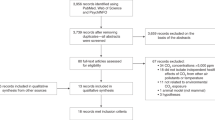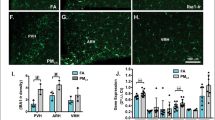Abstract
Human obesity has evolved into a global epidemic. Interestingly, a similar trend has been observed in many animal species, although diet composition, food availability and physical activity have essentially remained unchanged. This suggests a common factor—potentially an environmental factor affecting all species. Coinciding with the increase in obesity, atmospheric CO2 concentration has increased more than 40%. Furthermore, in modern societies, we spend more time indoors, where CO2 often reaches even higher concentrations. Increased CO2 concentration in inhaled air decreases the pH of blood, which in turn spills over to cerebrospinal fluids. Nerve cells in the hypothalamus that regulate appetite and wakefulness have been shown to be extremely sensitive to pH, doubling their activity if pH decreases by 0.1 units. We hypothesize that an increased acidic load from atmospheric CO2 may potentially lead to increased appetite and energy intake, and decreased energy expenditure, and thereby contribute to the current obesity epidemic.
Similar content being viewed by others
Background
Obesity is one of the most significant and rapidly increasing health problem today, giving rise to an explosion in health care costs. The amount of energy we consume and how much we move around are the key factors in body weight regulation, but why a positive energy balance emerges in the majority of individuals in societies with access to abundant food calories is not completely understood. Our lifestyle has changed dramatically since the beginning of industrialization, and some of these changes probably affect energy balance in ways that favour weight gain. Some experts consider the dogma that voluntary changes in food intake and physical activity are the principal causes of the obesity epidemic to be circumstantial.1 Moralizing the problem and socially stigmatizing the obese has done nothing to stem the epidemic.2 The causal mechanisms behind the obesity epidemic are clearly multifactorial and complex. Results from both human and animal studies indicate the existence of an intricate homeostatic system for maintaining body weight within a fairly narrow range and the presence of a powerful hedonic system that can interfere with this relatively finely tuned regulation. If central mechanisms in this homeostatic system, which involves endocrine feedback from the periphery to the brain, are influenced by changes in the environment, then even small environmental changes could potentially cause changes in body weight. We propose a novel hypothesis involving a mechanism in which a small change in blood pH caused by increased concentrations of CO2 in our environment may contribute to the development of obesity.
A possible connection between the obesity epidemic and the environment
Coinciding with the sharp increase in the prevalence of human obesity over the last 50 years, weight gain has also been observed in animals. A recent study found that 24 populations of 8 different species, including laboratory animals that had been fed the same diets for decades, all displayed significant weight gain.3 This suggests that a shared environmental factor, favouring weight gain, may be involved in the regulation of energy balance. Such a factor has yet to be identified.
The atmospheric concentration of CO2 has remained between 180–280 p.p.m. over the past two million years.4 However, with the increasing industrialization of modern societies, CO2 concentration has risen to 400 p.p.m., with an additional increase to 550 p.p.m. anticipated by 2050 (Figure 1). Thus, the partial pressure of CO2 in the outside air has increased by nearly 40% over the last century. Henry's law states that the solubility of a gas is directly proportional to the partial pressure of that gas above the solvent, so we can assume that humans now absorb around 40% more CO2 in body tissue. This increased acidic load is only partially counterbalanced by increased excretion of renal acid (H+). It is therefore reasonable to assume that blood and cerospinal fluid are now slightly more acidic than 100 years ago. Additionally, in industrialized cultures, we spend 80–90% of our time indoors, where CO2 concentrations are often higher.5
It is well established that acidity of the blood increases (decreased pH) with increasing CO2 concentration in the inhaled air. In a number of studies of a duration of several weeks, a lower pH was maintained throughout, indicating that full renal compensation did not occur.6, 7 Acidosis is also compensated by increased ventilation, but apparently, this does not happen before CO2 concentration in inspired air is about 10 000 p.p.m. (1%).8
How can increased atmospheric CO2 and low blood pH lead to obesity?
In parts of the brain (hypothalamus), there are specialized nerve cells (orexin neurons), which are involved in the regulation of appetite, energy metabolism, wakefulness, feeding behaviour and libido. These orexin neurons are extremely sensitive to changes in pH, a decrease of only 0.1 pH units leading to a doubling in their activity.9 Given the observed increase in atmospheric CO2 concentration from 280 to 400 p.p.m., and the decrease in the pH of blood observed in animals and humans exposed to CO2 concentrations ranging from 7000 to 15 000 p.p.m.,6, 10 we estimate that the firing rate of the orexigen neurons has increased by approximately 1% in the course of the last century. The basis for the calculation: if the pH decrease with 0.1 pH units, the firing rate will change nearly 100%.9 During the past century, the CO2 concentration has increased from 280 to 400 p.p.m. (400 to 280 p.p.m.). Additionally, we assume that there is a linear relationship between the pH in the blood and the CO2 concentration in the inspired air. Two studies was identified where blood pH was measured in relation to exposure to low concentration of CO2. A human study with exposure to 7000 p.p.m. CO2 and a blood pH decrease of 0.05 units10 and a guinea pigs study with exposure to 15 000 p.p.m. CO2 and a blood pH decrease of 0.05 units.6 The human study was used as a basis for our estimate. The CO2 exposure was 7000 p.p.m. and the exposure difference normal air was 6600 p.p.m. (7000–400 p.p.m.). According to (Williams et al.,9) will a drop in pH of 0.05 pH units means a 50% increase in the firing rate. A rough estimate of the proposed increase in the firing rate would be: 50%/6600 p.p.m.=0.008%/p.p.m. multiplied with 120 p.p.m. (the last 100 years increase in atmospheric CO2)=0.96%.
This calculation does not take an additional acidic contribution of indoor air into account. We hypothesize that a lower blood pH, caused primarily by rising CO2 concentrations in air, indoors as well as outdoors, leads to elevated activity in parts of the hypothalamus, resulting in increases in appetite and energy intake. These pH-sensitive neurons also regulate wakefulness, and increased activity in the neurons will lead to increased wakefulness, which has also been associated with weight gain.2 Interestingly, numerous studies have shown an association between short sleep duration and increased body mass index.11 The National Sleep Foundation (www.sleepfoundation.org) finds that sleep duration has been decreasing steadily over the past century. Activation of the orexin system will lead to less sleep, and lack of sleep has been reported to decrease levels of the satiety hormone leptin, increase levels of the hunger hormone ghrelin, and alter glucose homeostasis.12 Additionally, in patients with obstructive sleep apnoea, characterized by both a hypercapnic and a hypoxic state, energy expenditure (EE) has been found to decrease with increasing severity of the affliction.13
Narcolepsy is a disease related to sleep. It is caused by an autoimmune destruction of orexin neurons. Leptin concentrations in these patients are only half that found in healthy control subjects matched for age, sex, body mass index, waist/hip ratio and fat mass.14 Leptin is involved in the regulation of both energy intake and of EE, and narcoleptic patients, despite eating less than normal people, they still become obese.15 Lower orexin levels decrease appetite, so the weight gain may be a result of decreased EE caused by lower circulating plasma leptin levels.15 This effect of leptin may be the same as that linking shorter duration of sleep to obesity.16 Orexin neurons are inhibited by glucose and leptin, and leads to decreased appetite, wakefulness, sympathetic stimulation, libido and need for pleasure/reward. In addition, the orexin neurons stimulate centres in the brain forming adrenocorticotrophic hormone, which in turn leads to increased production of cortisol by the kidneys. Increased cortisol levels are known to increase appetite and favour abdominal energy storage in pathological doses (Cushing disease).2 Interestingly, short sleep duration and chronic stress cause increased levels of cortisol and have resulted weight gain in some individuals.17, 18
If elevated environmental levels of CO2 reduce blood pH, and this then leads to an increased firing rate in the orexin neurons in the hypothalamus, then several key processes in the brain could be affected, leading to greater appetite and increased energy storage.
Testing the hypothesis
The relationship between increased exposure to CO2 and the processes described above has not been investigated previously. An obvious way to test the hypothesis is to conduct long-term animal studies, in which the effects of exposure to elevated levels of CO2, as the sole intervention factor, on the amount of food eaten, weight gain, growth rate, and if there are measurable effects, whether they might be explained by a decrease in blood pH. By use of metabolic cages with different CO2 concentrations, differences in EE (respiratory calorimetry) and locomotion can be measured simultaneously. Ideally, the animals should be followed over several generations, because the acidic stress is likely to influence the production of cortisol, which is known to induce foetal programming, resulting in increased risk of obesity and related diseases in the offspring.19 It may be possible to identify effects in animals that are pertinent to humans.
Long-term studies in humans prohibited by ethical considerations, but short-term studies to test the effects of moderately elevated levels of CO2 on appetite regulation could be performed in respiration chambers.20, 21
We conducted a small, short-term, crossover design, pilot study, with 6 young healthy males (body mass index 20–25 kg m− 2 and 22–35 years) randomly exposed to ambient air or 8000 p.p.m. CO2 for 7.5 h in respiration chambers. The study was reviewed by the Science Ethics Committee for The Capital Region of Denmark, journal number: H-4-2011-FSP, and the committee judged that because of the very limited intervention that the project was not notifiable. Before the study, we have obtained informed consent from all the participants. Subjects’ ad libitum energy consumption increased numerically by 6.1% when exposed to CO2 (95% CI: −5.7 to 17.9%, s.d.: 14.8%). The results are presented in Figure 2. Though not statistically significant, probably due to insufficient statistical power, the results was in the expected direction and suggests that the hypothesis is worthy of exploration in larger cohorts, both animal and human, using suitable designs to minimize individual variability in the measured outcomes.
Conclusion
The cost of health care for an increasingly overweight and obese population has increased dramatically, and efforts to halt the obesity epidemic have failed. We propose that exposure to increasing amounts of CO2 in the atmosphere changes regulatory neuronal mechanisms in the hypothalamus, resulting in decreased EE and sleep, and increased appetite and obesity. If substantiated, this could prove to be an additional mechanism in the multifactorial causes of obesity, which will necessitate major political, economic and environmental interventions to combat the obesity epidemic.
References
Keith SW, Redden DT, Katzmarzyk PT, Boggiano MM, Hanlon EC, Benca RM et al. Putative contributors to the secular increase in obesity: exploring the roads less traveled. Int J Obes (Lond) 2006; 30: 1585–1594.
Zinn AR . Unconventional wisdom about the obesity epidemic. Am J Med Sci 2010; 340: 481–491.
Klimentidis YC, Beasley TM, Lin HY, Murati G, Glass GE, Guyton M et al. Canaries in the coal mine: a cross-species analysis of the plurality of obesity epidemics. Proc Biol Sci 2011; 278: 1626–1632.
Honisch B, Hemming NG, Archer D, Siddall M, McManus JF . Atmospheric carbon dioxide concentration across the mid-Pleistocene transition. Science 2009; 324: 1551–1554.
Klepeis NE, Nelson WC, Ott WR, Robinson JP, Tsang AM, Switzer P et al. The National Human Activity Pattern Survey (NHAPS): a resource for assessing exposure to environmental pollutants. J Expo Anal Environ Epidemiol 2001; 11: 231–252.
King CT, Williams EE, Mego JL, Schaefer KE . Adrenal function during prolonged exposure to low concentration of carbon dioxide. Am J Physiol 1955; 183: 46–52.
Pingree BJ . Acid-base and respiratory changes after prolonged exposure to 1% carbon dioxide. Clin Sci Mol Med 1977; 52: 67–74.
Wong KL . Carbon Dioxide. Subcommittee on Spacecraft Maximum Allowable Concentrations. Spacecraft Maximum Allowable Concentrations for Selected Airborne Contaminants. National Academic Press: Washington, DC, 1996; Ch.B3.
Williams RH, Jensen LT, Verkhratsky A, Fugger L, Burdakov D . Control of hypothalamic orexin neurons by acid and CO2 . Proc Natl Acad Sci USA 2007; 104: 10685–10690.
Messier AA, SCHAEFER KE . The effect of chronic hypercapnia on oxygen affinity and 2,3-diphosphoglycerate. Respir Physiol 1971; 12: 291–296.
Kripke DF, Garfinkel L, Wingard DL, Klauber MR, Marler MR . Mortality associated with sleep duration and insomnia. Arch Gen Psychiatry 2002; 59: 131–136.
Spiegel K, Tasali E, Leproult R, Van CE . Effects of poor and short sleep on glucose metabolism and obesity risk. Nat Rev Endocrinol 2009; 5: 253–261.
Major GC, Doucet E, Trayhurn P, Astrup A, Tremblay A . Clinical significance of adaptive thermogenesis. Int J Obes (Lond) 2007; 31: 204–212.
Kok SW, Meinders AE, Overeem S, Lammers GJ, Roelfsema F, Frölich M et al. Reduction of plasma leptin levels and loss of its circadian rhythmicity in hypocretin (orexin)-deficient narcoleptic humans. J Clin Endocrinol Metab 2002; 87: 805–809.
Ganjavi H, Shapiro CM . Hypocretin/Orexin: a molecular link between sleep, energy regulation, and pleasure. J Neuropsychiatry Clin Neurosci 2007; 19: 413–419.
Knutson KL, Van CE . Associations between sleep loss and increased risk of obesity and diabetes. Ann NY Acad Sci 2008; 1129: 287–304.
Spiegel K, Leproult R, L’hermite-Baleriaux M, Copinschi G, Penev PD, Van CE . Leptin levels are dependent on sleep duration: relationships with sympathovagal balance, carbohydrate regulation, cortisol, and thyrotropin. J Clin Endocrinol Metab 2004; 89: 5762–5771.
Oliver G, Wardle J, Gibson EL . Stress and food choice: a laboratory study. Psychosom Med 2000; 62: 853–865.
Remacle C, Bieswal F, Reusens B . Programming of obesity and cardiovascular disease. Int J Obes Relat Metab Disord 2004; 28 (Suppl 3): S46–S53.
Astrup A, Buemann B, Christensen NJ, Madsen J . 24-h energy expenditure and sympathetic activity in postobese women consuming a high-carbohydrate diet. Am J Physiol 1992; 262: E282–E288.
Buemann B, Astrup A, Quaade F, Madsen J . 24-h energy expenditure and substrate oxidation rates are unaffected by body fat distribution in obese women. Metabolism 1994; 43: 109–113.
Author information
Authors and Affiliations
Corresponding author
Ethics declarations
Competing interests
Professor Arne Astrup is salaried author for Ude & Hjemme; salaried associate editor of American Journal of Clinical Nutrition; advisor or member of advisory boards for a number of food and pharmaceutical producers and so on: Communications and Scientific Advisory Board of The Global Dairy Platform, Kraft Health & Wellness Advisory Council, Glenview, Il, USA; Scientific Board member, Beer Knowledge Institute (Amsterdam); Novo, NeuroSearch, Basic Research, Pathway Genomics Corporation, La Jolla, CA, USA; and Jennie Craig, Carlsbad, CA, USA; and recipient of honoraria as speaker for a wide range of Danish and international concerns. Ownership, in accordance with the Danish University regulations, of inventions and patents where Arne Astrup is co-inventor. Arne Astrup has, from the university, been granted shares in Mobile Fitness A/S. LG Hersoug and A Sjödin declare no conflict of interest.
Rights and permissions
This work is licensed under the Creative Commons Attribution-NonCommercial-No Derivative Works 3.0 Unported License. To view a copy of this license, visit http://creativecommons.org/licenses/by-nc-nd/3.0/
About this article
Cite this article
Hersoug, LG., Sjödin, A. & Astrup, A. A proposed potential role for increasing atmospheric CO2 as a promoter of weight gain and obesity. Nutr & Diabetes 2, e31 (2012). https://doi.org/10.1038/nutd.2012.2
Received:
Accepted:
Published:
Issue Date:
DOI: https://doi.org/10.1038/nutd.2012.2
Keywords
This article is cited by
-
Impact of CO2 emission on life expectancy in India: an autoregressive distributive lag (ARDL) bound test approach
Future Business Journal (2023)
-
The health consequences of greenhouse gas emissions: a potential pathway
Environmental Geochemistry and Health (2022)
-
Direct human health risks of increased atmospheric carbon dioxide
Nature Sustainability (2019)
-
Can houseplants improve indoor air quality by removing CO2 and increasing relative humidity?
Air Quality, Atmosphere & Health (2018)
-
Adaptations of leptin, ghrelin or insulin during weight loss as predictors of weight regain: a review of current literature
International Journal of Obesity (2014)





